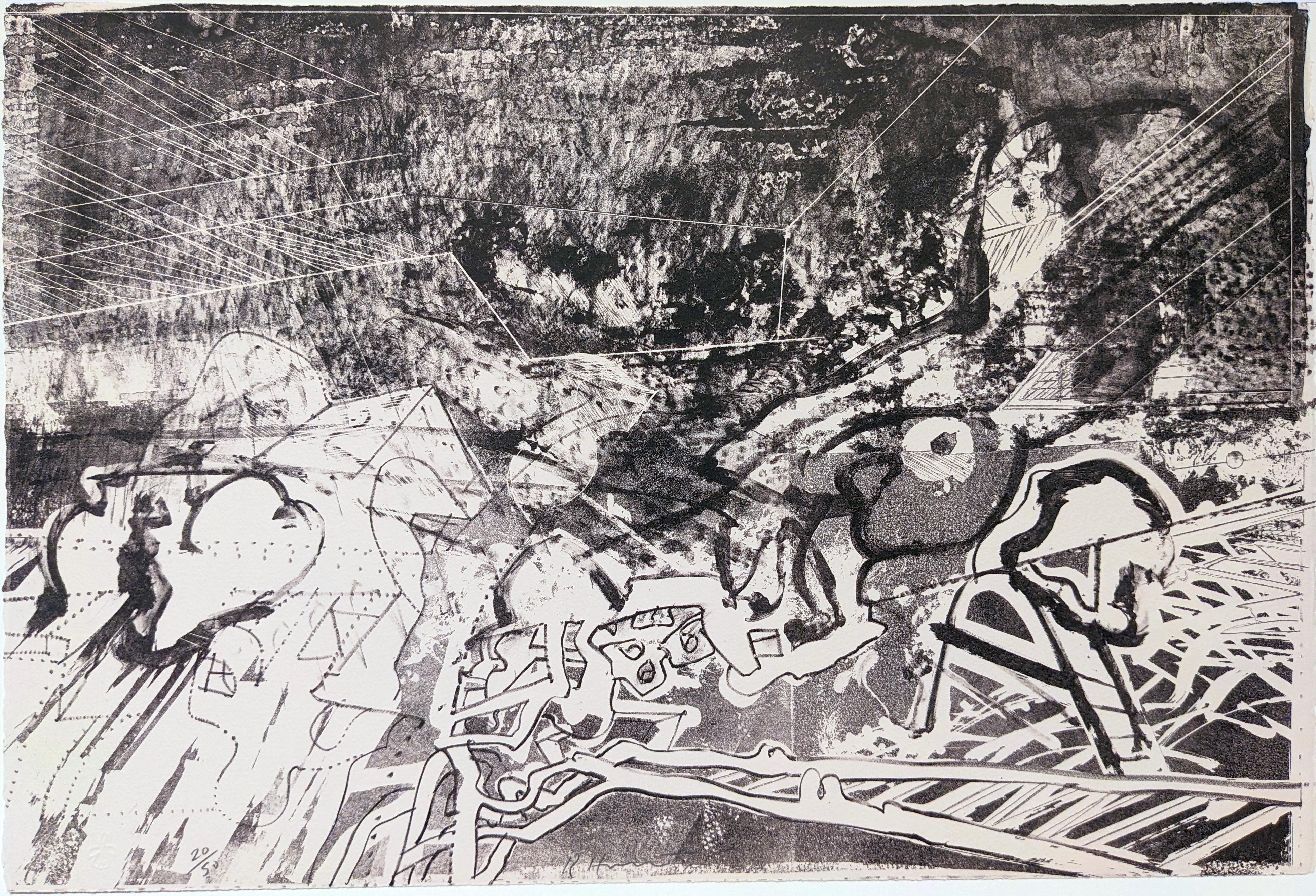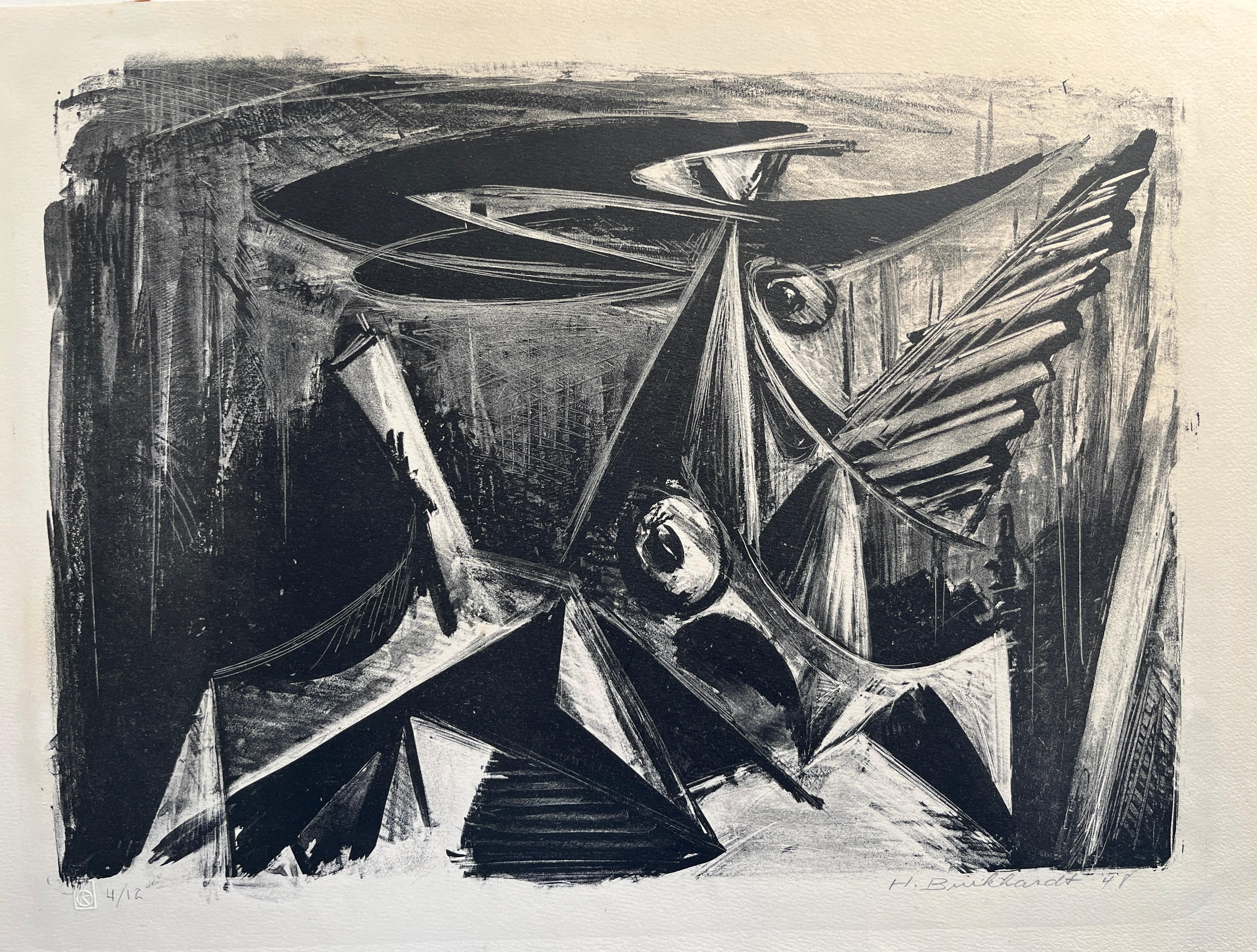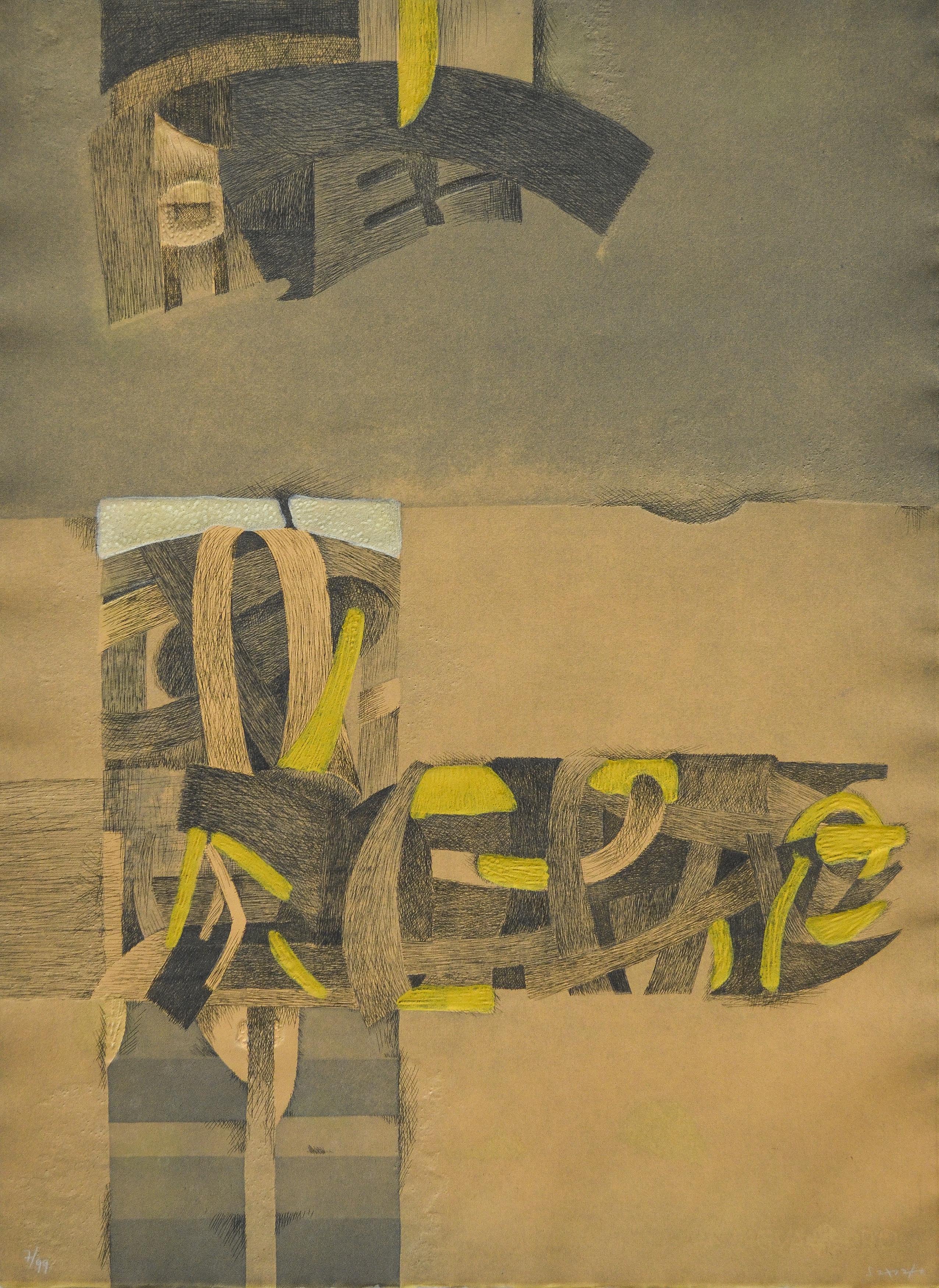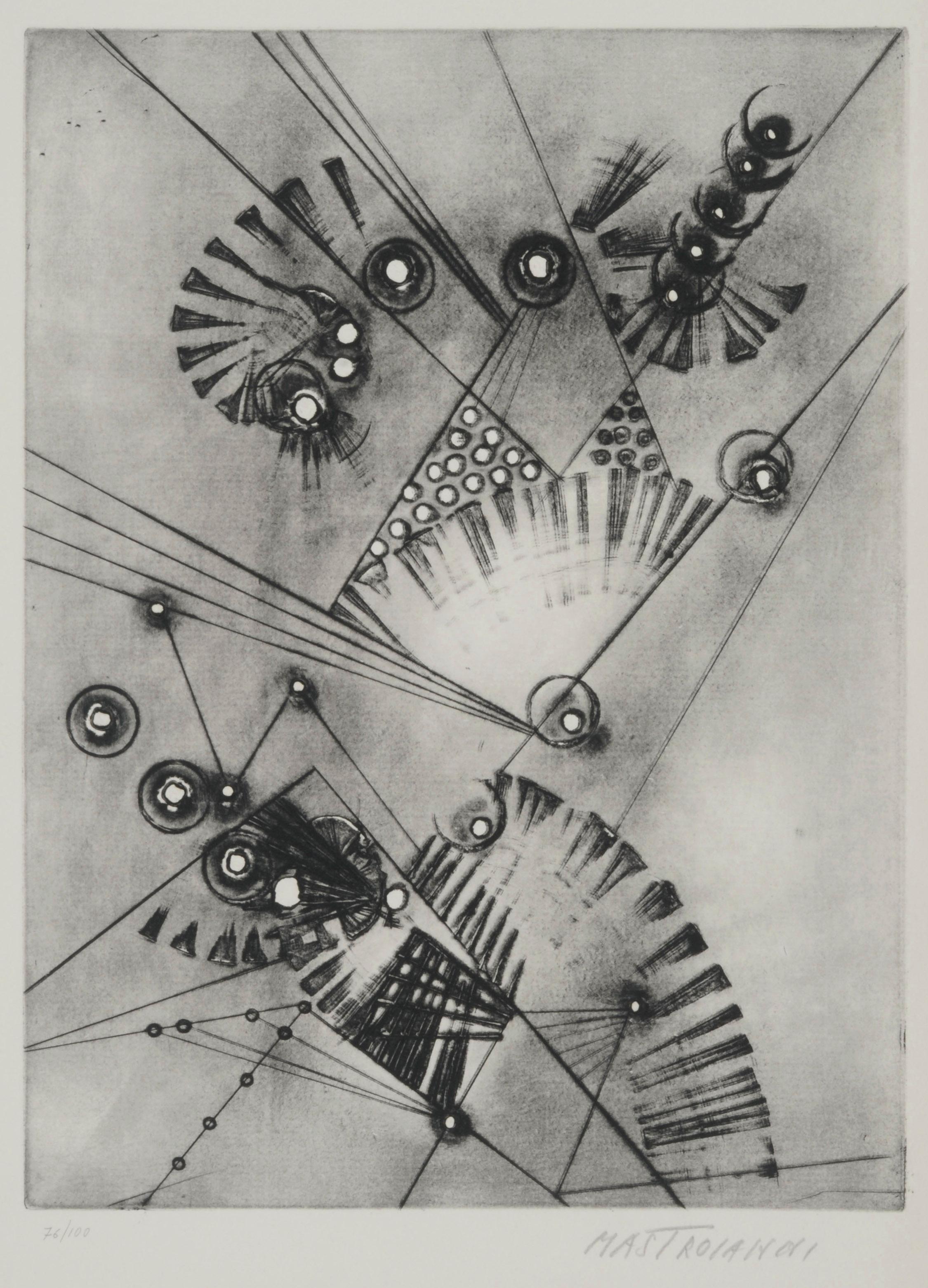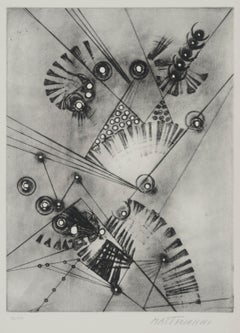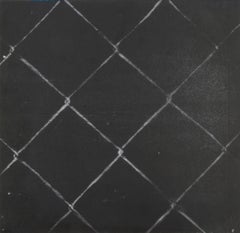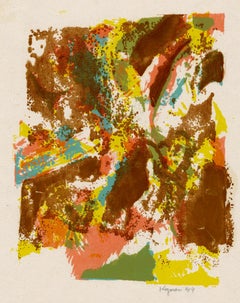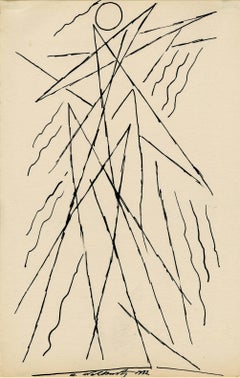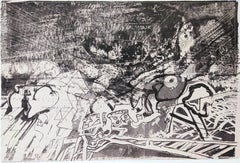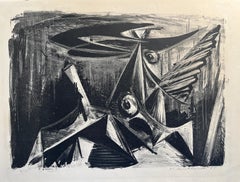Want more images or videos?
Request additional images or videos from the seller
1 of 5
Charles William SmithUntitled1939
1939
$700
£543.78
€617
CA$1,000.87
A$1,094.97
CHF 571.88
MX$13,085.21
NOK 7,184.94
SEK 6,762.17
DKK 4,607.68
About the Item
Untitled
Color woodcut, 1939
Unsigned as issued
Signed and dedicated by the artist on the justification page (see photo)
From:
Abstractions By Charles Smith
Forward by Carl O. Schniewind
Published by The Johnson Company Publishers, New York, 1939
Edition: Unknown
Image size: 9 1/4 x 8 inches
Condition: Slight aging to the wove paper, barely noticeable
Provenance: Isaac Richard Singer, Virginia (see photo)
Alexander Mack Memorial Library, Bridgewater, VA (see photo)
Born in Lofton, Virginia, in 1893, Charles William Smith studied at the University of Virginia summer school, the Corcoran Art School, and Yale University's School of Fine Arts. He taught at the University of Virginia, the College of William and Mary, and the New York School of Printing. Smith moved to Richmond in 1925 where he worked as an artist for Whittet & Shepperson, a local printing firm. In 1929 he taught art at the Richmond Division of the College of William and Mary. For the next four years, Smith worked out of his apartment on Monument Avenue as a commercial artist. He became chair of the art department at Bennington College in Bennington, Vermont, in 1936 and taught there until 1947. Smith taught at the University of Virginia from 1947 until his retirement in 1963 and was the first chairman of the art department. Charles W. Smith died in Charlottesville in 1987.
Smith learned how to use gouges and chisels from his father, a patternmaker for local industries. Early in his career he turned to linoleum block printing. He explained in his 1926 book, Linoleum Block Printing, that the basic techniques for linoleum block and wood block were similar. The artist transferred his design to the block and then cut the design in relief. Areas not to be printed were cut away. The difference lay in the inability of the linoleum to permit fine lines or much detail. Linoleum blocks produced prints with large areas of color and minimal lines.
Carl O. Schniewind (1900-1957)
Curator of Prints and Drawings at the Brooklyn Museum from 1935 to 1940 and Art Institute of Chicago, 1940-1957. Schniewind was the son of a prominent chemical engineer in New York who studied art as a hobby. After the early death of his father, his mother returned to Germany with her two sons in 1914. In Germany he contracted tuberculosis and was treated in a Swiss sanitorium. He studied medicine at the Universities of Zürich and Bern, Switzerland, before changing fields into art history. He received his Ph.D. at the university in Heidelberg, Germany. Schniewind amassed an extensive collection of Daumier graphics and drawings, which he sold at auction in 1933. The same year he married Heidi Bretscher. The couple lived in Paris until 1935, when Schniewind joined the Brooklyn Museum's as librarian and curator of Department of Prints and Drawings, succeeding Susan Hutchinson (q.v.). During his tenure in Brooklyn he oversaw the formation of the Department of Prints and Drawings, which separated from the library collections in 1937. Schniewind acquired important European drawings, including those by Pablo Picasso, Vincent van Gogh, and Edgar Degas. He left the Museum in 1940 to head the Prints department at the Art Institute of Chicago, succeeded in Brooklyn in 1941 by Una Johnson (q.v.). At Chicago, Schniewind mounted the 1941 show "The First Century of Printmaking," writing a catalog with Fogg Museum curator Elizabeth Mongan (q.v.). In 1944, his Posada exhibition was one of the first in the United States to showcase this Mexican graphic artist. Schniewind understood the value of acquiring entire sketchbooks of artists. Under his direction, the AIC's department acquired the sketchbooks of Paul Cèzanne, Odion Redon, James Ensor, Theodore Gèricault and Henri Toulouse-Lautrec, many of which were published as scholarly facsimilies. He also acquired important drawings by Rembrandt, Fragonard and Watteau. While one a buying and research trip in Italy, he died of complications of tuberculosis with which he had struggled his entire adult life. Schniewind was a connoisseur and scholar who took advantage of the works-on-paper art market to acquire magnificent examples of both modern and old-master prints and drawings.
- Creator:Charles William Smith (1893-1987, American)
- Creation Year:1939
- Dimensions:Height: 9.25 in (23.5 cm)Width: 8 in (20.32 cm)
- Medium:
- Movement & Style:
- Period:
- Condition:
- Gallery Location:Fairlawn, OH
- Reference Number:Seller: FA119551stDibs: LU1407580382
About the Seller
5.0
Recognized Seller
These prestigious sellers are industry leaders and represent the highest echelon for item quality and design.
Gold Seller
Premium sellers maintaining a 4.3+ rating and 24-hour response times
Established in 1978
1stDibs seller since 2013
822 sales on 1stDibs
Typical response time: <1 hour
Associations
International Fine Print Dealers Association
- ShippingRetrieving quote...Shipping from: Fairlawn, OH
- Return Policy
Authenticity Guarantee
In the unlikely event there’s an issue with an item’s authenticity, contact us within 1 year for a full refund. DetailsMoney-Back Guarantee
If your item is not as described, is damaged in transit, or does not arrive, contact us within 7 days for a full refund. Details24-Hour Cancellation
You have a 24-hour grace period in which to reconsider your purchase, with no questions asked.Vetted Professional Sellers
Our world-class sellers must adhere to strict standards for service and quality, maintaining the integrity of our listings.Price-Match Guarantee
If you find that a seller listed the same item for a lower price elsewhere, we’ll match it.Trusted Global Delivery
Our best-in-class carrier network provides specialized shipping options worldwide, including custom delivery.More From This Seller
View AllComposition
By Umberto Mastroianni
Located in Fairlawn, OH
Composition
Original carborundum engraving, c. 1970
Signed: Mastroianni in pencil lower right (see photo)
Edition: 100 (76/100) (see photo)
Printed on a heavy laid paper
Condition:...
Category
1970s Modern Abstract Prints
Materials
Etching
Untitled
By Rebekah Wilhelm
Located in Fairlawn, OH
Signed, titled and dated verso
Monotype on lithographic plate (unique)
Created while the artist was at the University of Delaware
With distre...
Category
2010s Contemporary Abstract Prints
Materials
Monotype
Untitled
By Myron Kozman
Located in Fairlawn, OH
Untitled
Screen print, 1941
Signed and dated in pencil lower right
From an unnumbered edition of 6
Condition: Excellent
Image size: 7 1/4 x 5 3/4 inches
Sheet size: 10 x 8 inches
Pr...
Category
1940s Abstract Abstract Prints
Materials
Screen
Abstraction
By Abraham Walkowitz
Located in Fairlawn, OH
Signed and dated in ink lower center
Provenance:
Charlotte Bergman, noted collector and patron of Walkowitz. See photo for additional information.
Category
1930s Modern Abstract Drawings and Watercolors
Materials
Ink, Pen
Untitled
By Henri Goetz
Located in Fairlawn, OH
Untitled
Engraving, drypoint & carborundum, c. 1960's
Signed and numbered in pencil lower margin (see photos)
Edition: 25 (9/25)
Printed by the artist
Condition: Adhesive residue on ...
Category
1960s Abstract Expressionist Abstract Prints
Materials
Engraving
Untitled
By Henri Goetz
Located in Fairlawn, OH
Untitled
Signed in pencil lower right (see photo)
Edition: 25 (9/25) (see photo)
Engraving, drypoint & carborundum
Printed by the artist
Condition: Excellent, slight residue on rever...
Category
1960s Abstract Expressionist Abstract Prints
Materials
Drypoint, Etching
You May Also Like
Untitled II
By Joseph Zirker
Located in San Francisco, CA
Artist: Joseph Zirker (American, born 1924)
Title: Untitled
Year: 1988
Medium: Color monotype
Paper: Arche 88
Size: 42 x 30 inches
Signature: Signed and dated in pencil by the artist
Printer: The artist
Condition: Very good
Frame: Unframed
About the artist.
Joseph Zirker is a noted American modern artist, educator, lecturer that was born on August 13, 1924 in Los Angeles, California, United States. As a young man he Served with United States Navy, from 1944 to 1946.
He attended the University of California in Los Angeles 1946—1947. He got a bachelor of Fine Arts at the University of Denver in 1949 and a master of Fine Arts, University Southern California, 1951.
He was a printer and research fellow at Tamarind Lithography Workshop in Los Angeles, 1961—1963. Lecturer University Southern California, 1963. Instructor Los Angeles County Art Institute, 1964, San Jose City College, California, 1966—1980.
Lecturer Stanford University, 1981—1983, 1986—1990. All along his carer, he had numerous acclaimed shows in the U.S and abroad. He is known worldwide as an innovator in monotype and printmaking. His works are represented in private and public collections, both in the USA and worldwide, including:
Grunwald Collection, U.C.L.A., Los Angeles, California,
Brooklyn Museum, Brooklyn, New York
Free Library of Philadelphia, Pennsylvania
June Wayne, Tamarind Lithography Workshop, Los Angeles, California
Tamarind Archives, Tamarind Lithography Workshop, Los Angeles, California,
Charles White, Los Angeles, California
Stanley Freeman Collection, Los Angeles County Museum, Los Angeles, California
Ben Smith...
Category
Late 20th Century American Modern Abstract Prints
Materials
Monotype
Untitled III
By Joseph Zirker
Located in San Francisco, CA
Artist: Joseph Zirker (American, born 1924)
Title: Untitled
Year: 1988
Medium: Color monotype
Paper: Arche 88
Size: 42 x 30 inches
Signature: Signed and dated in pencil by the artist
Printer: The artist
Condition: Very good
Frame: Unframed
About the artist.
Joseph Zirker is a noted American modern artist, educator, lecturer that was born on August 13, 1924 in Los Angeles, California, United States. As a young man he Served with United States Navy, from 1944 to 1946.
He attended the University of California in Los Angeles 1946—1947. He got a bachelor of Fine Arts at the University of Denver in 1949 and a master of Fine Arts, University Southern California, 1951.
He was a printer and research fellow at Tamarind Lithography Workshop in Los Angeles, 1961—1963. Lecturer University Southern California, 1963. Instructor Los Angeles County Art Institute, 1964, San Jose City College, California, 1966—1980.
Lecturer Stanford University, 1981—1983, 1986—1990. All along his carer, he had numerous acclaimed shows in the U.S and abroad. He is known worldwide as an innovator in monotype and printmaking. His works are represented in private and public collections, both in the USA and worldwide, including:
Grunwald Collection, U.C.L.A., Los Angeles, California,
Brooklyn Museum, Brooklyn, New York
Free Library of Philadelphia, Pennsylvania
June Wayne, Tamarind Lithography Workshop, Los Angeles, California
Tamarind Archives, Tamarind Lithography Workshop, Los Angeles, California,
Charles White, Los Angeles, California
Stanley Freeman Collection, Los Angeles County Museum, Los Angeles, California
Ben Smith...
Category
Late 20th Century American Modern Abstract Prints
Materials
Monotype
untitled
By Richard Howard Hunt
Located in New York, NY
Richard Hunt untitled lithograph 1978. Number 20 from an edition of 50, measuring 15 by 22.5 inches. This print has been professionally matted.
Category
1970s Abstract Abstract Prints
Materials
Lithograph
Untitled
By Hans Burkhardt
Located in New York, NY
Lithograph, 1948. Signed by the artist and dated in pencil, lower right. Numbered 4/12 in pencil, lower left.
Category
1940s American Modern Abstract Prints
Materials
Lithograph
Untitled Edition 7 of 99
By Fernando de Szyszlo
Located in Miami, FL
Fernando de Szyszlo was a Peruvian painter best known for using pre-Columbian imagery and muted palette. De Szyszlo’s art was an attempt at reinventing Surrealist themes in a Latin A...
Category
20th Century Abstract Prints
Materials
Engraving, Etching
Untitled
By Louisa Chase
Located in New York, NY
Louisa Chase was born in Panama City, Panama. Seven years later, her family moved to Lancaster, Pennsylvania. She studied painting and sculpture at Syracuse University and at the Yal...
Category
Late 20th Century Abstract Prints and Multiples
Materials
Lithograph
